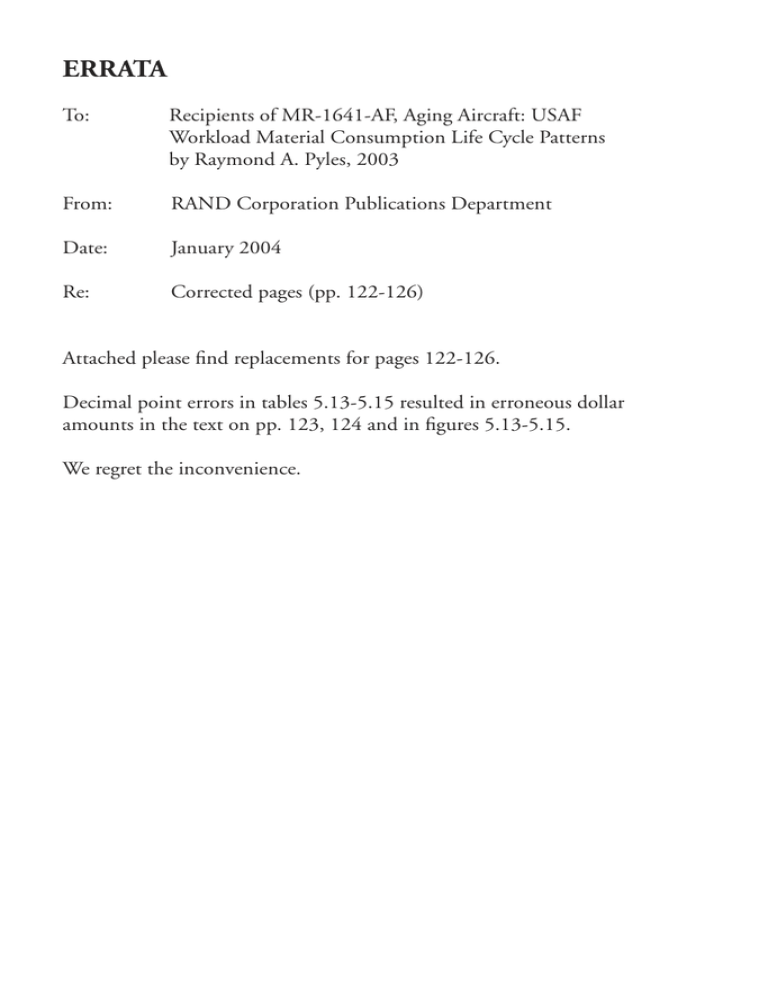ERRATA
advertisement

ERRATA To: Recipients of MR-1641-AF, Aging Aircraft: USAF Workload Material Consumption Life Cycle Patterns by Raymond A. Pyles, 2003 From: RAND Corporation Publications Department Date: January 2004 Re: Corrected pages (pp. 122-126) Attached please find replacements for pages 122-126. Decimal point errors in tables 5.13-5.15 resulted in erroneous dollar amounts in the text on pp. 123, 124 and in figures 5.13-5.15. We regret the inconvenience. 122 Aging Aircraft First, we examined Cook’s distance and leverage values in a scatterplot and found that all data points were within acceptable levels for Cook’s distance. Table 5.13 Age Affects Depot-Level-Reparable Repair Costs in the Full Regression Results of regression analysis Analysis Performed: Sun 03 Mar 2002 22:03:06 Data set used: D:\Documents\Dbases\Analysis\DataFiles\DeflDLRCost Rule set used: D:\Documents\Dbases\Analysis\Rules\ConsDLRCostRules Dependent variable: LRep$ Total sum of squares 1.5684E+07 Regression sum of squares 8.2014E+06 Residual error 7.4822E+06 F-Statistic 12.7620 Degrees of freedom 14,163 R-squared 0.5229 Standard Variable Coefficient Error t-Statistic Probability Constant 379.46832 Bmbr 330.63425 91.16771 3.6267 6.77E-04 C2 –312.01353 78.60159 –3.9696 2.87E-04 Crgo –304.54298 56.95272 –5.3473 1.31E-05 Helo –381.14791 70.73309 –5.3885 1.20E-05 Tnkr –392.12872 97.12723 –4.0373 2.43E-04 Trnr –81.94107 73.44513 –1.1157 0.2653 FAge 2.61081 3.67539 0.7104 0.5144 Flyaway –0.73895 0.14049 –5.2600 1.56E-05 Year98 –9.02363 8.64848 –1.0434 0.2987 FAge*Fly 0.07562 0.02235 3.3834 1.27E-03 Pulse5 –155.46611 123.58602 –1.2580 0.2075 Pulse10 153.08101 102.29941 1.4964 0.1325 Ramp5 393.45139 216.73392 1.8154 0.0677 Ramp10 –284.14923 301.90677 –0.9412 0.6498 Age-Related Workload and Material Cost Growth: Findings 123 Practical Implications of the Regression Equation for DLR Repair Requirements In Figure 5.13, which displays the forecast computed per-flying-hour expected-value DLR repair requirements for the $30-million fighter and the $100-million cargo aircraft fleets, we can see that the fighter would require more DLR repair expenditures per flying hour throughout its first 60 years of operation than would the cargo aircraft. (Fighters are only rarely operated beyond 30 years.) Both the negative cargo coefficient and the negative flyaway-cost coefficient contribute to that effect. The $100-million flyaway cost lowers the basic requirement by $79 per flying hour, and the cargo coefficient lowers it another $294 (see Table 5.14). Table 5.14 Age Affects Depot-Level-Reparable Repair Costs in the Reduced Regression Results of regression analysis Analysis Performed: Sun 03 Mar 2002 22:07:15 Data set used: D:\Documents\Dbases\Analysis\DataFiles\DeflDLRCost Rule set used: D:\Documents\Dbases\Analysis\Rules\ConsDLRCostRules Dependent variable: LRep$ Total sum of squares 1.5684E+07 Regression sum of squares 7.8437E+06 Residual error 7.8399E+06 F-Statistic 24.2975 Degrees of freedom 7,170 R-squared 0.5001 Standard Variable Coefficient Error t-Statistic Probability Constant 421.06569 Bmbr 417.94321 77.19352 5.4142 1.12E-05 C2 –248.78963 73.65361 –3.3778 1.28E-03 Cargo –248.99831 47.11592 –5.2848 1.46E-05 Helo –342.62010 63.21326 –5.4201 1.11E-05 Tnkr –309.87809 66.92529 –4.6302 5.97E-05 Flyaway –0.79061 0.09541 –8.2865 1.02E-07 FAge*Fly 0.06626 0.01875 3.5347 8.51E-04 124 Aging Aircraft Table 5.15 Depot-Level-Reparable Repair Costs Did Not Decelerate with Age Results of regression analysis Analysis Performed: Sun 03 Mar 2002 22:08:55 Data set used: D:\Documents\Dbases\Analysis\DataFiles\DeflDLRCost Rule set used: D:\Documents\Dbases\Analysis\Rules\ConsDLRCostRules Dependent variable: LRep$ Total sum of squares 1.5684E+07 Regression sum of squares 7.8453E+06 Residual error 7.8383E+06 F-Statistic 21.1438 Degrees of freedom 8,169 R-squared 0.5002 Standard Variable Coefficient Error t-Statistic Probability Constant 417.39865 Bmbr 413.96890 80.35187 5.1520 1.93E-05 C2 –249.19173 73.89586 –3.3722 1.30E-03 Cargo –250.91390 48.37646 –5.1867 1.79E-05 Helo –343.37444 63.52518 –5.4053 1.15E-05 Tnkr –316.52077 76.15448 –4.1563 1.81E-04 Flyaway –0.79873 0.10531 –7.5847 2.73E-07 FAge*Fly 0.06781 0.02059 3.2937 1.59E-03 FAge202 0.03785 0.20503 0.1846 0.8480 Nevertheless, the more-expensive cargo aircraft’s requirement grows more rapidly, because of the age–flyaway cost interaction term. Thus, the fighter’s DLR requirement would grow about $2 per flying hour each year, but the cargo aircraft’s requirement would grow over three times as fast, at $7 per flying hour per year. In that case, the fighter flying 300 hours per year would encounter DLR repair cost growth of about $600 additional repair demands per year, and the cargo aircraft flying 500 hours per year would experience annual growth of about $3,300. Each fighter of a wing of 54 fighters flying 300 hours per year would cause the USAF’s DLR repair costs to grow about $32,000 annually, whereas each cargo aircraft wing of 30 flying 500 hours per year would cause about $99,000 annual growth. Age-Related Workload and Material Cost Growth: Findings 125 RAND MR1641-5.13 DLR repair expenses ($FY98/FH) 1,200 $30M fighter $100M cargo 1,000 800 600 400 200 0 0 20 40 Age (years) 60 80 Figure 5.13—DLR Repair Expenditures Grow Steadily as Aircraft Age Despite the difference in their annual growth rates, it would take over 60 years for the cargo aircraft’s DLR repair costs per flying hour to catch up with the fighter’s. While it is difficult to see in Figure 5.14, which shows how aircraft age affects the range of likely DLR repair requirements for a fighter aircraft, the range of likely DLR repair requirements fans out as the aircraft age increases. The fanning-out is more noticeable in Figure 5.15, which shows DLR repair requirements for the more-expensive cargo aircraft. FINDINGS FOR GENERAL STOCK DIVISION MATERIAL CONSUMPTION Table 5.16 shows the parameter coefficient estimates for the full regression of General Stock Division (GSD) material expenditures as aircraft fleets age. The full regression found the age–flyaway cost interaction term (FAge*Fly) significantly related to GSD consumption, 126 Aging Aircraft RAND MR1641-5.14 DLR repair expenses ($FY98/FH) 1,200 Lower bound Predicted Upper bound 1,000 800 600 400 200 0 0 20 40 Age (years) 60 80 Figure 5.14—DLR Repair Expenditures for Fighters Vary Widely RAND MR1641-5.15 DLR repair expenses ($FY98/FH) 1,200 Lower bound Predicted Upper bound 1,000 800 600 400 200 0 0 20 40 Age (years) 60 Figure 5.15—Variability in DLR Repair Expenditures for Cargo Aircraft Increases Noticeably as Fleets Age 80

